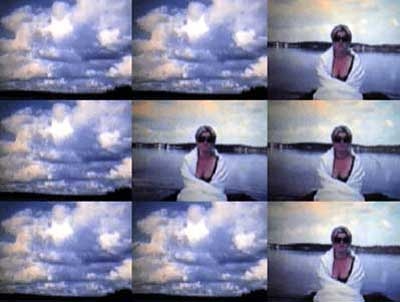Vacations, weddings and birthdays were recorded with rattling cameras on expensive reels. Ever since video systems have become smaller and cheaper, making home movies has become as normal as brewing coffee or playing a cassette. Minute-long movies have become hours of video, arbitrarily strewn-together pictures and sounds from family life.
And where the culture of audio-video images is closing in on us the
most, i.e., in the world of the home movie, there is hardly any direction or structure. This lack of form and timing results in many sweet, funny and beautiful moments and meaningful peaks quickly becoming unbearable banalities.
Mari Soppela's Family Files cd-rom uses, as its visual raw material, the home movies made by her and her husband, Leo Anemaet, filmed in the archaic Super-8 medium. The material is divided into fifteen episodes from their family life, recorded over the past three years. Examples: their wedding, their excursions to Paris and Hanover, the journey to the North Pole, visits to her family in the Finnish countryside, a vacation on Sardinia, the birth of the children, their new house in Amsterdam.
But how come watching these extremely recognizable pictures of familial bliss doesn't lead to a depressing encounter with random banalities? Because of the form with which the cd-rom's user views and controls these images. This cd-rom's interface is as radical as it is clear, which results in a balance being struck between intimacy and distance. Without symbolism, without interpretation, and without artistic mystification, these highly recognizable commonplaces demonstrate their poetry.
The opening screen is a mosaic of stills. It allows the user access to the fifteen episodes, each of which has its own date and location name. Every episode can be viewed in two different ways. In both methods, the screen is divided into nine windows. A pass of the mouse sets the nine film loops in motion. They only last for a few seconds, and they all convey moments, gestures, impressions of the same location. A day, a week, a month becomes a matrix of nine loops. The linearity of the cinema and the non-linearity of the interactive medium are woven together. The breathtaking landscapes of the Arctic Circle, the carefully filmed pictures and the filmic, sometimes intensely romantic music made by Leo Anemaet (which can always be heard in the background) invite the user to piece together a tableau of moments and images according to his or her own taste. As a whole, the nine windows don't pretend to give a complete representation of the episode. They are relaxed, intimate pictures, and yet their fragmentary and poetic character never makes the user feel like a voyeur.
The second way of viewing these same fifteen episodes is shown by a screen with four windows which offer another choice of film loops. Clicking on one of the windows evokes a Russian doll effect: the picture is reduced to a quarter of its original size, and is then surrounded by even smaller versions of the surrounding windows. You can keep clicking until an almost abstract screen of pure rhythm and color is created. The loops are so well-chosen that you invariably wind up with something that is as surprising as it is beautiful. This splintering into miniaturized repetition is a classical means of evoking the mysterious profundities of the surface. And with pictures which are as neutrally represented and deceptively pedestrian as these, it is a very successful means.
The cd-rom has a formal, matrix-like structure. The interface is quite simple: a table of contents, fifteen episodes, two modes, one with a pass of the mouse and the other with a mouse click. It is precisely this radical absence of interpretive links concerning the images' content which lends these pictures their value. All of the selections and editing decisions (from the choice of Super-8 and the choice of the loops to the composition of the screens) help to elicit a curious, uninhibited perusal from the user. The clear order of the neutral form effortlessly invites the user to play with these snippets from someone else's private past. All of the moments and faces remain nameless, retain their integrity, and remain resolute. They have much to tell, but only by means of the user's daydreaming, searching interaction.
This is all result of Soppela's interface, a structure built all the way from the code on up, which lends these open, everyday pictures a form, a means of address. The automatic, formal structure undermines any kind of unambiguity or sentimentality. The clarity of the interface appeals to the user's aesthetic sensibility. The visual game is not a metaphor; it does not illustrate, but rather allows access to the vulnerability, the melancholy, the pleasure, the beauty which is hidden in home movies. Soppela is not a video artist, pasting together personal pictures with a black box. She writes in the electronic medium, and does so in the most fundamental sense of the word. She creates forms with allow the user to see pictures which are both everyday and less everyday, which are filled with meaning. And all of this stems from the subtle power of a keen mind. And love.
translation douglas heingartner
